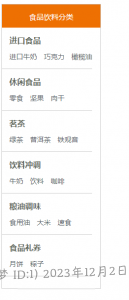练习
练习1
效果图
![图片[1]-盒子模型 – 北梦の博客-北梦の博客](https://wpstatic.b52m.cn/wp-content/uploads/2023/12/练习1.png)
代码
<!DOCTYPE html>
<html lang="en">
<head>
<meta charset="UTF-8">
<meta name="viewport" content="width=device-width, initial-scale=1.0">
<title>1</title>
<style>
* {
/* 清除所有元素内外边距 */
padding: 0;
margin: 0;
}
.box {
height: 600px;
width: 220px;
border: 1px solid rgb(160, 155, 155);
/* 元素水平居中 */
margin: 0 auto;
/* 元素顶部外边距的距离 */
margin-top: 100px;
font-size: 16px;
}
.header {
background: rgb(255, 123, 0);
height: 50px;
color: white;
text-align: center;
/* 设置文字高度与元素高度一致可以实现垂直居中的效果 */
line-height: 50px;
/* 添加下框线 */
border-bottom: 1px solid darkgray;
}
.body {
color: rgb(121, 107, 107);
width: 200px;
height: 85px;
/* 添加下框线 */
border-bottom: 1px solid darkgray;
}
.text p {
font-weight: bold;
/* 设置外边距-左边 */
margin-left: 15px;
height: 50px;
/* 设置行高 */
line-height: 50px;
}
.text-p span {
font-size: 14px;
/* 设置外边距-左边 */
margin-left: 15px;
}
</style>
</head>
<body>
<div class="box">
<div class="header">
食品饮料分类
</div>
<div class="body">
<div class="text">
<p>进口食品</p>
<div class="text-p">
<span>进口牛奶</span>
<span>巧克力</span>
<span>橄榄油</span>
</div>
</div>
</div>
<div class="body">
<div class="text">
<p>休闲食品</p>
<div class="text-p">
<span>零食</span>
<span>坚果</span>
<span>肉干</span>
</div>
</div>
</div>
<div class="body">
<div class="text">
<p>茗茶</p>
<div class="text-p">
<span>绿茶</span>
<span>普洱茶</span>
<span>铁观音</span>
</div>
</div>
</div>
<div class="body">
<div class="text">
<p>饮料冲调</p>
<div class="text-p">
<span>咖啡</span>
<span>牛奶</span>
<span>饮料</span>
</div>
</div>
</div>
<div class="body">
<div class="text">
<p>油调味粮</p>
<div class="text-p">
<span>食用油</span>
<span>大米</span>
<span>素食</span>
</div>
</div>
</div>
<div class="body">
<div class="text">
<p>食品礼券</p>
<div class="text-p">
<span>月饼</span>
<span>粽子</span>
</div>
</div>
</div>
</div>
</body>
</html>练习2
效果图
![图片[2]-盒子模型 – 北梦の博客-北梦の博客](https://wpstatic.b52m.cn/wp-content/uploads/2023/12/练习2.png)
代码
<!DOCTYPE html>
<html lang="en">
<head>
<meta charset="UTF-8">
<meta name="viewport" content="width=device-width, initial-scale=1.0">
<title>2</title>
<style>
* {
/* 清除所有元素内外边距 */
padding: 0;
margin: 0;
}
.box {
height: 100px;
width: 800px;
background-color: bisque;
/* 设置弹性布局 */
display: flex;
/* 元素水平居中 */
margin: 0 auto;
}
.button {
/* 设置外边距-顶边 */
margin-top: 20px;
height: 50px;
width: 100px;
/* 设置边框 */
border: 1px solid #b8b4b4;
background-color: rgb(214, 208, 201);
/* 设置圆角,左上,右上,左下,右下 */
border-radius: 80px 80px 80px 80px;
/* 设置文字高度与元素高度一致可以实现垂直居中的效果 */
line-height: 50px;
text-align: center;
font-size: 14px;
/* 设置外边距-左边 */
margin-left: 50px;
}
.button:hover {
background-color: red;
}
</style>
</head>
<body>
<div class="box">
<div class="button">电视影音</div>
<div class="button">洗箱洗衣机</div>
<div class="button">空调</div>
<div class="button">厨卫</div>
<div class="button">小家电</div>
</div>
</body>
</html>练习3
效果图
![图片[3]-盒子模型 – 北梦の博客-北梦の博客](https://wpstatic.b52m.cn/wp-content/uploads/2023/12/练习3.png)
代码
<!DOCTYPE html>
<html lang="en">
<head>
<meta charset="UTF-8">
<meta name="viewport" content="width=device-width, initial-scale=1.0">
<title>3</title>
<style>
* {
/* 清除所有元素内外边距 */
padding: 0;
margin: 0;
}
h2,
h3 {
font-weight: bold;
color: rgb(204, 0, 0);
}
p {
color: rgb(0, 102, 0);
}
.body p {
font-weight: bold;
}
.header {
text-align: center;
}
.box {
/* 元素水平居中 */
margin: 0 auto;
width: 1000px;
height: 690px;
background-image: url(./images/bg_border.jpg);
padding-top: 25px;
}
.a {
margin: 0 auto;
width: 950px;
height: 650px;
background-image: url(./images/bg_poem.jpg);
padding-top: 10px;
}
.text {
line-height: 30px;
margin: 10px;
}
</style>
</head>
<body>
<div class="box">
<div class="a">
<div class="text">
<div class="header">
<h2>忆江南(1)</h2>
<p>唐.白居易</p>
</div>
<div class="body">
<p>江南好,风景旧曾谙。(2)</p>
<p>日出江花红胜火,春来江水绿如蓝,(3)</p>
<p>能不忆江南。</p>
</div>
<h3>作者介绍</h3>
<p>
772-846,字乐天,太原(今山西)人。唐德宗朝进士,元和三年(808)拜左拾遗,后贬江州(今属江西)司马,移忠州(今属四川)刺史,又为苏州(今属江苏)、同州(今属陕西大荔)刺史。晚居洛阳,自号醉吟先生、香山居士。其诗政治倾向鲜明,重讽喻,尚坦易,为中唐大家。也是早期词人中的佼佼者,所作对后世影响甚大。
</p>
<br>
<h3>注释</h3>
<p>
(1)据《乐府杂录》,此词又名《谢秋娘》,系唐李德裕为亡姬谢秋娘作。又名《望江南》、《梦江南》等。分单调、双调两体。单调二十七字,双凋五十四字,皆平韵。(2)谙(音安):熟悉。(3)蓝:蓝草,其叶可制青绿染料。
</p>
<h3>品评</h3>
<p>
此词写江南春色,首句“江南好”,以一个既浅切又圆活的“好”字,摄尽江南春色的种种佳处,而作者的赞颂之意与向往之情也尽寓其中。同时,唯因“好”之已甚,方能“忆”之不休,因此,此句又已暗逗结句“能不亿江南”,并与之相关阖。次句“风景旧曾谙”,点明江南风景之“好”,并非得之传闻,而是作者出牧杭州时的亲身体验与亲身感受。这就既落实了“好”字,又照应了“忆”字,不失为勾通一篇意脉的精彩笔墨。三、四两句对江南之“好”进行形象化的演绎,突出渲染江花、江水红绿相映的明艳色彩,给人以光彩夺目的强烈印象。其中,既有同色间的相互烘托,又有异色间的相互映衬,充分显示了作者善于著色的技巧。篇末,以“能不忆江南”收束全词,既托出身在洛阳的作者对江南春色的无限赞叹与怀念,又造成一种悠远而又深长的韵味,把读者带入余情摇漾的境界中。
</p>
</div>
</div>
</div>
</body>
</html>© 版权声明
THE END











暂无评论内容